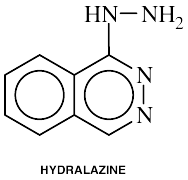
Hydralazine
Brand Names: Alazine, Apresoline, Apresazide, Ser-Ap-Es, Unipres
Clinical Names: Hydralazine
Summary
generic name: Hydralazine
trade name: Alazine®, Apresoline®, Apresazide®, Ser-Ap-Es®, Unipres®
type of drug: Vasodilator.
used to treat: Hypertension.
overview of interactions:
• nutrient affected by drug: Vitamin B6
(Pyridoxine)
• nutrients affecting drug performance: All Foods, especially Fiber
• substance affecting drug activity: Alcohol
Interactions
nutrient affected by drug: Vitamin B6
(Pyridoxine)
• mechanism: Hydralazine alters enzymatic pathways and increases B6 excretion to lessen levels of vitamin B6 in the body.
• adverse drug effects: Hydralazine can cause neuropathies due to vitamin B6 deficiency.
• nutritional support: Individuals taking hydralazine should consult with their prescribing physician and/or a nutritionally trained healthcare profressional regarding the use of vitamin B6 to counter adverse effects of hydralazine. Those taking hydralazine might benefit from supplementing with 50-100 mg vitamin B6 per day. However, extended use of B6 at this level can produce side effects in some individuals.
nutrients affecting drug performance: All Foods, especially Fiber
• mechanism: Hydralazine absorption and/or disposition kinetics may be altered by food, especially foods such as fiber that would slow the rate of nutrient absorption.
(Semple HA, et al. Ther Drug Monit 1991 Jul;13(4):304-308.)
substance affecting drug activity: Alcohol
• mechanism: Hydralazine intentionally lowers blood pressure; alcohol also lowers blood pressure by dilating blood vessels. The use of alcohol while taking hydralazine could result in unintentionally lowering blood pressure to unsafe levels, thereby increasing the possibility of lightheadedness, dizziness and/or fainting and subsequent injury. Case reports also indicate the possibility of cardiac irregularities associated with this interaction, as well as aggravations of gastric lesions due to alcohol consumption.
(Smith BA, et al. Ann Emerg Med. 1992 Mar;21(3):326-330; Bhandare PN, et al.
Indian J Physiol Pharmacol. 1992 Apr;36(2):130-132; Rataboli PV, et al. Indian J Physiol
Pharmacol. 1993 Jan;37(1):88-90.)
• dietary concerns: Individuals taking hydralazine should avoid the consumption of alcohol, or alcohol-containing substances.


Please read the disclaimer concerning the intent
and limitations of the information provided here.
Do not rely solely on the information in this article.
The information presented in Interactions is for
informational and educational purposes only. It is based on scientific
studies (human, animal, or in vitro), clinical experience, case
reports, and/or traditional usage with sources as cited in each
topic. The results reported may not necessarily occur in all
individuals and different individuals with the same medical conditions
with the same symptoms will often require differing treatments. For
many of the conditions discussed, treatment with conventional medical
therapies, including prescription drugs or over-the-counter
medications, is also available. Consult your physician, an
appropriately trained healthcare practitioner, and/or pharmacist for
any health concern or medical problem before using any herbal products
or nutritional supplements or before making any changes in prescribed
medications and/or before attempting to independently treat a medical
condition using supplements, herbs, remedies, or other forms of
self-care.
References
Bhandare PN, Rataboli PV, Diniz D'Souza RS, Dhume VG. Aggravating action of hydralazine on ethanol-induced gastric lesions.
Indian J Physiol Pharmacol. 1992 Apr;36(2):130-132.
Holt GA. Food and Drug Interactions. Chicago: Precept Press, 1998, 131-132.
Rataboli PV, et al. Effect of antihypertensive drugs on ethanol induced gastric lesions: is there a correlation with mucosal blood flow?
Indian J Physiol Pharmacol. 1993 Jan;37(1):88-90.
Raskin NH, Fishman RA. Pyridoxine-deficiency neuropathy due to
hydralazine. N Engl J Med 1965 Nov 25;273(22):1182-1185.
Semple HA, Koo W, Tam YK, Ngo LY, Coutts RT. Interactions between hydralazine and oral nutrients in humans.
Ther Drug Monit 1991 Jul;13(4):304-308.
Abstract: To help clarify whether food or enteral nutrients decrease hydralazine relative bioavailability, eight subjects were given oral hydralazine under four nutritional conditions: fasted (F), with a standard breakfast (SB), with a bolus of enteral nutrients (EB), and with a slow infusion of enteral nutrients administered by nasogastric tube (EI). The area under the curve and maximum concentration values were much higher under the fasted and enteral infusion conditions than under the standard breakfast or enteral bolus conditions, indicating that the absorption and/or disposition kinetics of hydralazine may be altered by food. The median (range) values for these parameters were 2,641 (385-4,747) and 87 (4.5-224) for F; 1,189 (202-1,737) and 15 (3.5-33.9) for SB; 999 (227-3,576) and 11 (2.5-50) for EB; and 3,068 (313-4,917) ng/ml/min and 113 (3.6-235) ng/ml for EI. Furthermore, the rate of nutrient administration, but not necessarily the physical form, of the nutrients appears to be a significant factor in determining the magnitude of the food effect. The nutrient interaction should be accounted for in patients receiving hydralazine and enteral nutrition concomitantly.
Smith BA, Ferguson DB. Smith BA, et al. Acute hydralazine overdose: marked ECG abnormalities in a young adult.
Ann Emerg Med. 1992 Mar;21(3):326-330.
Abstract: Although hydralazine is a commonly prescribed antihypertensive agent, reports of acute human poisoning are uncommon. Most of the literature focuses on chronic toxicity, most notably, the drug-induced systemic lupus erythematosus syndrome. A case of acute hydralazine overdose associated with marked ECG ST segment depression in a young adult is presented. Although the patient also had mild hypotension, acidemia, and ethanol intoxication, the ECG abnormality was alarming and suggestive of myocardial ischemia. The patient was managed conservatively in an ICU setting, and the metabolic and ECG abnormalities resolved. No reports of such marked ECG changes associated with acute hydralazine poisoning in a young adult could be found. Clinical and experimental data on acute hydralazine exposure suggest that the possibility of direct drug effects, including positive inotropic and chronotropic effects and myocardial cell injury, should be considered.
Threlkeld DS, ed. Diuretics and Cardiovasculars, Antihypertensives, Vasodilators, Hydralazine. In:
Facts and Comparisons Drug Information. St. Louis, MO: Facts and Comparisons, Dec 1993.
Trovato A, Nuhlicek DN, Midtling JE. Drug-nutrient interactions. Am Fam Physician 1991 Nov;44(5):1651-1658.

